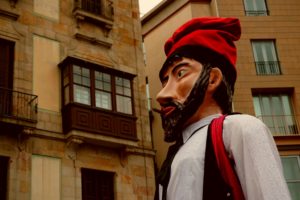The real origins and history of the Catalan equivalent of Santa Claus are Barcelona’s best-kept secrets.
As I was digging into the urban history of Barcelona, I stumbled into one of the best kept and hidden secrets of the city. The secret is related to the Catalan equivalent of Santa Claus – Tió de Nadal, and to a popular figurine called El Caganer (the Crapper). The discovery changed the way I’m looking at the catalan Christmas.
So let’s start at the beginning… (reader discretion is advised)

The dirtiest job in the city
During the early industrial era, more than 150 years ago, the trade of human excrements had become a big, organized and lucrative business in Barcelona. Shit was valuable, because local farmers used it as natural fertilizer to get better crops. In those days, human fecal waste was not generally used as a fertilizer, because it infected people with parasites. However, the Catalan society had found a way to prevent the infections. They learned how to organise effective quality controls of human waste and to use it to cultivate parasite free vegetables.
In Barcelona, until the late 19th century, people accumulated their body waste inside pits called ‘black holes’ located in their apartments. They also released their urine through the windows to the streets.
The trained professionals who evaluated and collected human excrements were Master Well Cleaners called ‘Poceros’. Traditionally these Masters went knocking from door to door and extracted the fecal waste from wells called ‘black holes’.
Instead of asking money for the cleaning job, they paid cash for the material collected, because the waste could be resold to local farmers with benefit. The price was fixed according to the quality and quantity of the material collected.
Before modern day chemistry, there existed only one way for the Poceros to check the real quality of the human waste. They poked the shit with a stick to check its consistency, and used their trained sense of taste as an advanced method or technique to control the quality.
The biggest marketplace of human waste in the world
In the summer of 1854, the government gave in to public pressure and allowed Barcelona’s city walls to be torn down. With the extra space for housing, the district of Eixample was born. Unlike the congested, epidemic-prone old town within the walls, the new city extension would become an efficient and livable place. Also, a new and complex sewage network was built, but not for all types of waste. The brand new sewer system evacuated only liquids from the houses and rainwater from the streets, but the human feces were stored inside the domestic wells like before.
The famous Plaça Catalunya in the city’s center was originally designed as a huge marketplace for human waste.
The ever-growing number of new citizens in Barcelona meant more clients for the fecal waste pickers and their contractors. As the fecal waste business was booming, the designer of the district of Eixample, Ildefons Cerdà i Sunier, calculated that the entire extension of Barcelona could be built with the help of the money earned from human excrements.
Income flushed down the drain
Unfortunately for some, the fecal waste business died little by little when the first cheap artificial fertilizers and ceramic toilets came on to the market. Also, the upcoming 1888 Barcelona Universal Exposition closed the waste Market at Plaça Catalunya. Nevertheless, many residents, especially the less fortunate ones, were protesting against this technological and industrial revolution.
Some protested because they had lost their respected profession and others because they had lost their ‘natural’ income. The ‘stingiest’ couldn’t understand why somebody would be willing to flush their precious material ‘down the drain’ and to spent money to buy a ceramic water closet.
On January 24th 1914, at Calle Plains number 7, a water closet exploded and three people were injured. (Source)
Finally, it took years for people to get accustomed to the water closet. During the first years, because of bad design and accumulation of methane, gas accidents caused many precious toilet seats to explode. Even at the beginning of the 20th century, the safety of toilets raised polemic and worries in Barcelona.
Human feces and Catalan Family Christmas traditions
If you visit Barcelona during the Christmas season, you’ll find nativity scenes in many shop windows, squares and churches. Inside these nativity scenes you can search for a popular figurine called El Caganer (the Crapper). The figurine is always hiding somewhere with his pants down and pooping. The typical figurine wears traditional Catalan clothes with a red cap (the barretina), like the master Pocero in the good old days…
Another tradition celebrating the long lost income of human waste business is called Tió de Nadal (sometimes called just Tió or Tronca). It is a mythical figure associated with the Catalan Christmas. Typically, it’s a piece of wood with two or four legs, a broadly smiling painted circular face, and a red cap. Tió de Nadal is traditionally brought home at the beginning of December. It is taken care of by the children. The children need to make sure that it won’t get hungry and cold. It is fed and put to sleep under a warm red blanket. Finally during the Christmas it’s beaten with a stick and told to ‘poo’ the Christmas presents out. At the same time the people sing the special Christmas carol composed just for this special occasion: “Caga Tio, if you don’t poop well, I’ll hit you with a stick”.
Here is a Christmas video made by Escola Vedruna de Palafrugell with Tió de Nadal. Merry Christmas!